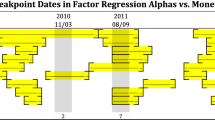Abstract
We evaluate the investment performance of hedge funds using an asset pricing model that is characterized by a piecewise-linear stochastic discount factor, and which we estimate using the generalized method of moments by minimizing the Hansen–Jagannathan distance. Our results show that, once non-linearities and public information are taken into account, there is only evidence of positive performance for the overall hedge fund index, equity-market neutral strategy and the global macro strategy.
Similar content being viewed by others
References
Agarwal V., Fos V., Jiang W. (2010) Inferring reporting biases in hedge fund databases from hedge fund equity holdings. Georgia State University, Mimeo
Agarwal V., Naik N. Y. (2004) Risks and portfolio decisions involving hedge funds. Review of Financial Studies 17: 63–98
Agarwal V., Bakshi G., Huij J. (2009) Higher-moment equity risk and the cross-section of hedge fund returns. Georgia State University, Mimeo
Chen Z., Knez P. (1996) Portfolio performance measurement: Theory and applications. Review of Financial Studies 9: 56–511
Cochrane J. (2005) Asset pricing. Princeton University Press, Princeton
Dahlquist M., Söderlind P. (1999) Evaluating portfolio performance with stochastic discount factors. Journal of Business 72: 83–347
Davies R. B. (1977) Hypothesis testing when a nuisance parameter is present only under the alternative. Biometrika 64: 247–354
Davies R. B. (1987) Hypothesis testing when a nuisance parameter is present only under the alternative. Biometrika 74: 33–43
Diebold F. X., Chen C. (1996) Testing structural stability with endogenous break point: A size comparison of analytic and bootstrap procedures. Journal of Econometrics 70: 221–241
Diez de los Rios, A., Garcia, R. (2010). Assessing and valuing the non-linear structure of hedge fund returns. Journal of Applied Econometrics (forthcoming).
Dittmar R. F. (2002) Nonlinear pricing kernels, kurtosis preference, and evidence from the cross section of equity returns. Journal of Finance 57: 369–403
Farnsworth H., Ferson W., Jackson D., Todd S. (2002) Performance evaluation with stochastic discount factors. Journal of Business 75: 473–503
Ferson W., Harvey C. (1999) Conditioning variables and the cross section of stock returns. Journal of Finance 54: 1325–1360
Fung W., Hsieh D. A. (2001) The risk in hedge fund strategies: Theory and evidence from trend followers. Review of Financial Studies 14: 313–341
Goetzmann W., Ingersoll J., Spiegel M., Welch I. (2007) Portfolio performance manipulation and manipulation-proof performance measures. Review of Financial Studies 20: 46–1503
Hansen B. (1996) Inference when a nuisance parameter is not identified under the null hypothesis. Econometrica 64: 413–430
Hansen L. P., Jagannathan R. (1997) Assessing specification errors in stochastic discount factor models. Journal of Finance 52: 557–590
Harvey C., Siddique A. (2000) Conditional skewness in asset pricing tests. Journal of Finance 55: 1263–1295
Hodrick R. J., Zhang X. (2001) Evaluating the specification errors of asset pricing models. Journal of Financial Economics 62: 327–376
Jagannathan R., Korajczyk R. A. (1986) Assesing the market timing performance of managed portfolios. Journal of Business 59: 217–235
Jagannathan R., Wang Z. (1996) The conditional CAPM and the cross-section of expected returns. Journal of Finance 51: 3–53
Kosowski R., Timmerman A., Wermers R., White H. (2006) Can mutual fund “stars” really pick stocks? New evidence from a bootstrap analysis. Journal of Finance 61: 2551–2595
Lhabitant F. S. (2004) Hedge funds: Myths and limits. Wiley, New York
Mitchell M., Pulvino T. (2001) Characteristics of risk and return in risk arbitrage. Journal of Finance 56: 75–2135
Stulz R. M. (2007) Hedge funds: Past, present, and future. Journal of Economic Perspectives 21: 175–194
Vanden J. M. (2004) Options trading and the CAPM. Review of Financial Studies 17: 207–238
Vanden J.M. (2006) Option coskewness and capital asset pricing. Review of Financial Studies 19: 1279–1320
Author information
Authors and Affiliations
Corresponding author
Additional information
The views expressed in this paper are those of the authors and do not necessarily reflect those of the Bank of Canada.
Rights and permissions
About this article
Cite this article
Diez de los Rios, A., Garcia, R. The option CAPM and the performance of hedge funds. Rev Deriv Res 14, 137–167 (2011). https://doi.org/10.1007/s11147-011-9062-9
Published:
Issue Date:
DOI: https://doi.org/10.1007/s11147-011-9062-9




